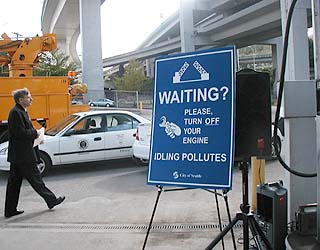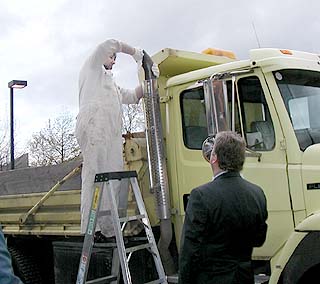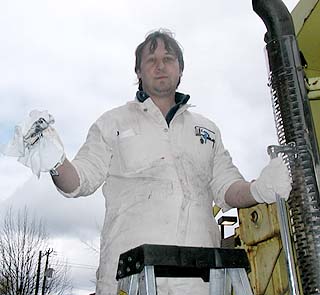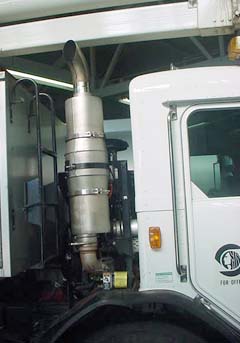
Surveys
DJC.COM
July 17, 2003
Clean air: saving our competitive advantage
City of Seattle

Photos courtesy of the city of Seattle
Seattle is ready to start a campaign to reduce unnecessary idling during long waits at intersections and drawbridges.
|
Clean, clear, healthy air has long been a quality that sets Seattle apart from other major U.S. cities. But there are unsettling signs that the central Puget Sound region is in danger of losing that distinction, due in large part to the growing use and numbers of cars, trucks (including sport utility vehicles), buses and boats.
While overall air quality throughout the U.S. has improved over the last 20 years, thanks in large part to the Clean Air Act and significantly cleaner vehicles and industries, three difficult issues top our region’s clean air agenda:
- In recent summers, the region has come uncomfortably close to exceeding federal standards for ozone, which contributes to the formation of smog, which in turn interferes with both public health and visibility.
- A 2002 study by the U.S. EPA, confirmed by Puget Sound Clean Air Agency data, places levels of toxic air pollution in the Seattle area in the top 5 percent nationwide, which significantly increasing cancer risks in our region. The agency attributes 70 percent or more of the problem to diesel emissions.
- A 2002 inventory of carbon dioxide and other “greenhouse gas” emissions by the city’s Office of Sustainability & Environment projects that emissions in the Seattle area will increase by nearly 20 percent by 2010 if current trends continue. More than half of these emissions, which scientists believe are accelerating global warming, come from transportation sources: cars, trucks, buses, boats and planes.
The good news is that a growing number of public and private fleet operators are stepping up to the challenge.
Last April, Seattle Mayor Greg Nickels and City Councilmember Heidi Wills announced a new Clean Green Fleet Action Plan aimed at minimizing fossil fuel consumption and emissions from the city’s fleet of 3,200 cars and trucks. The plan, unanimously endorsed by the City Council on Earth Day (April 22), sets a goal for the city fleet to be 100 percent “clean and green.” Eventually all city vehicles — from pickup trucks to police cruisers — will use the cleanest fuels and vehicle technologies available in each vehicle category.
The Office of Sustainability & Environment, with the city’s Fleets & Facilities Department and the Puget Sound Clean Air Agency, is studying life-cycle benefits and costs of various fuel and vehicle choice scenarios to determine how best to achieve this goal, and over what time frame.
In the meantime, the city is moving toward the goal:
- Starting this year, at least 50 percent of all new compact cars purchased by the city will be either alternative fuel vehicles (such as compressed natural gas) or vehicles that get at least 45 miles per gallon (such as hybrid gasoline-electric). This will add to the approximately 190 “clean and green” vehicles already in the city fleet.
- By the end of this year, the city’s diesel fleet will convert to a mixture of 80 percent ultra-low sulfur diesel and 20 percent biodiesel, a mu ch cleaner fuel made from a variety of renewable sources, including waste vegetable oils and soybean oil.
- Where appropriate, the city is increasing its use of Segway personal mobility vehicles (which run on $3 worth of electricity per year), and reducing its use of sport utility vehicles. (The city purchased only 10 SUVs in 2002 compared to 26 in 2001.)
- The city soon will launch an intensive awareness-raising program to promote environmentally responsible transportation choices and fuel-efficient vehicle operation by city employees, including a campaign to reduce unnecessary vehicle idling during long waits at intersections and drawbridges.

|

Using ultra-low-sulfur diesel fuel produces less soot, as evidenced by a white rag test. Another truck running on the same fuel outfitted with an oxidation catayst device produced a clean rag.
|
Seattle’s efforts are part of a growing regional focus on cleaner fuels and vehicles:
- The Puget Sound Clean Air Agency’s (PSCAA) Diesel Solutions program continues to gain momentum. Seattle, King County, Boeing and the Port of Seattle were the first fleet operators to voluntarily commit to using much cleaner ultra-low sulfur fuel, and retrofitting diesel vehicles with state-of-the-art pollution control technology. Together, these measures are reducing diesel emissions by up to 90 percent.
The program is now turning its attention to two additional important sources of diesel emissions: marine vessels (such as ferries and cruise ships) and off-road vehicles (such as heavy construction equipment).
- This past legislative session, the PSCAA led an effort to obtain funding for a statewide Clean School Bus Program. A recent Yale University study suggests that school children are exposed to levels of toxic diesel emissions that are five to 15 times higher than the general population experiences. And a report released last year by the Union of Concerned Scientists ranked Washington state’s school bus fleet as one of the two dirtiest in the country.
A Seattle City Light truck outfitted with an oxidation catalyst device.
- The Clean Cities Coalition — a consortium of fuel-makers, car manufacturers, transit agencies, utilities, and federal, state and local governments — is working to bolster the supply and demand of alternative fuels and alternative-fuel vehicles in the Puget Sound region.
This coalition — which includes the city of Seattle, King County, the Port of Seattle, and the Puget Sound Clean Air Agency — helped develop and secure the passage of several bills in the last state legislative session to create new incentives, including tax incentives for the purchase of alternative fuel vehicles and for in-state production of biodiesel and ethanol.
Why are initiatives such as these succeeding? They all employ innovation and collaboration toward the growing recognition that our health and our long-term livability depend on clean, clear, healthy air. Clean air is one of our key competitive advantages as a city and region.
Being mindful of the day-to-day transportation choices we make — as governments, as businesses and as individuals — is one of the most effective and powerful actions we can take to help preserve this legacy for future generations.
Steve Nicholas is director of the city of Seattle’s Office of Sustainability & Environment, and represents Seattle on the Puget Sound Clean Air Agency board of directors. For more information on the city’s Clean Green Fleet Action Plan and other sustainability initiatives, visit www.cityofseattle.net/environment. For more information on the Puget Sound Clean Air Agency and its programs, visit www.pscleanair.org.
Other Stories:
- Battle over keeping dams rages on
- Be prepared with a spill management plan
- What’s your vision for Seattle’s future?
- Hat Island gets a drink from the sea
- Foss Waterway cleanup kicks into high gear
- Reclaimed water — a ‘new’ water supply
- LOTT dives into reclaimed water
- Europe points the way to sustainability
- Old maps handy for site investigations
- Planning for an environmental emergency
- Engineered logjams: salvation for salmon
- Pierce County maps where its rivers move
- Development can be beneficial to wetlands
- Check out properties with microbial surveys
- Sculpting a park out of a brownfield
- Charting a sustainable course for the Sound
- Water rights no longer a hidden asset
- The economics of sustainability
- Laying the path for responsible education
- Squeezing more out of renewable energy
- Controlling mosquitos and the environment
- Beavers back in force in the Seattle area
- Our future: no time or resources to waste
- Port Townsend dock promotes fish habitat
- Brownfields program is here to stay
- Master Builders teaches green homebuilding
- A salmon-friendly solution on the Snake
Copyright ©2009 Seattle Daily Journal and DJC.COM.
Comments? Questions? Contact us.
